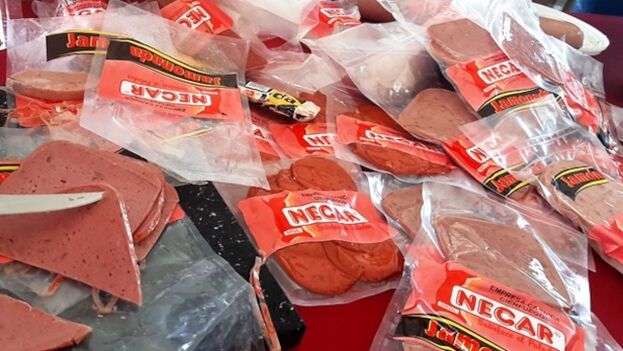
![]() 14ymedio, Havana, 23 February 2023 — The alternative that the Meat Company of Cienfuegos found to stay active is the production of sausages based on cassava, rice and cornstarch, due to the shortage of wheat and the low production of beef and pork on the Island. “We have had good results,” Luis Jiménez Marrero, an operator of the plant located in the municipality of Palmira, told the provincial newspaper 5 de Septiembre.
14ymedio, Havana, 23 February 2023 — The alternative that the Meat Company of Cienfuegos found to stay active is the production of sausages based on cassava, rice and cornstarch, due to the shortage of wheat and the low production of beef and pork on the Island. “We have had good results,” Luis Jiménez Marrero, an operator of the plant located in the municipality of Palmira, told the provincial newspaper 5 de Septiembre.
In Cuba, wheat flour is used in the production of ham, uncommon in other countries, but even wheat is absent in food production. “The mixture of the ingredients responds to current needs,” Jiménez Marrero said, while recognizing that the durability of the cold meat is still being analyzed and that “flavors conditioned to characteristics” are sought.
The ham produced with these new ingredients has been distributed in recreational centers and for domestic consumption in the form of cold cuts for sandwiches, the operator added, with “good acceptance” by the consumer. “We managed to make the product in small slices, which is easy for consumption: you open the package, take out the slice, put it on bread, and you now have a snack,” he explained to the local newspaper.
Cassava is the star substitute for wheat flour in Cuba and is used to make fish or bread croquettes, although in bakeries it has not been so popular due to its rapid expiration and the variations in taste. In addition, cassava starch is used in the pharmaceutical and cosmetic industry, and also as a substitute for malt in beer manufacturing.
The general shortage of products has led producers to explore new alternatives, such as in Pinar del Río, where soy is grown to meet the demand for feed in the pig sector. This cereal, high in protein and used to make milk of plant origin, is also a source of oil, a use that the Cuban authorities are currently analyzing, said Ortelio Rodríguez, sub-delegate of Agriculture of the province.
In statements to the local newspaper Guerrillero, the official explained that the province has 247 acres of soybeans, distributed in the municipalities of Pinar del Río, Consolación del Sur and Los Palacios. The goal, he added, is to obtain enough seeds to reach 2,471 acres in the Vueltabajo region in the second half of this year.
Soy is an “ideal” candidate for Cuban producers because its cultivation produces high yields with the application of few agricultural inputs, up to 3.5 tons per acre, in addition to adapting to extreme climatic conditions.
Rodríguez recalled that soybeans were previously grown on a “small scale” in the province, but there was resistance from the health system because there was a myth that it attracted pests that put tobacco plantations at risk. “The same diseases that attack soybeans also affect beans and, despite that, thousands of acres have been planted in Pinar del Río without us having had problems,” he said.
Soy was one of the life-saving crops of the Cuban economy, according to Raúl Castro’s promises in 2007, when he said that enough milk had to be produced for “everyone who wants to have a glass.” Since then, there has been little progress. The Cuban government produces soy yogurt for lactose intolerant people, although the common use of this derivative is due to the fact that milk production fails to meet national demand.
Translated by Regina Anavy
____________
COLLABORATE WITH OUR WORK: The 14ymedio team is committed to practicing serious journalism that reflects Cuba’s reality in all its depth. Thank you for joining us on this long journey. We invite you to continue supporting us by becoming a member of 14ymedio now. Together we can continue transforming journalism in Cuba.
